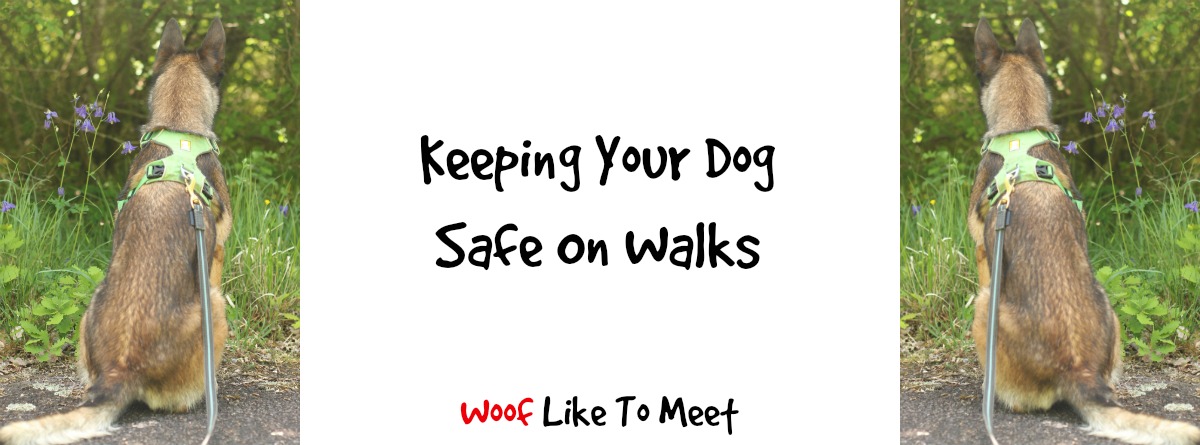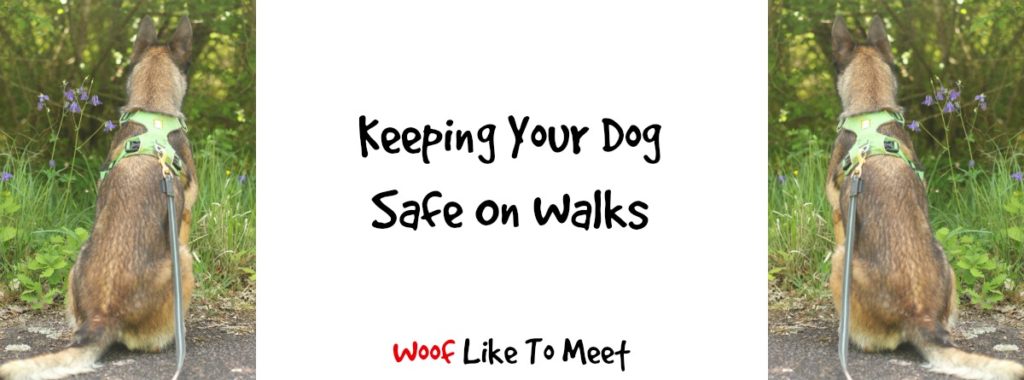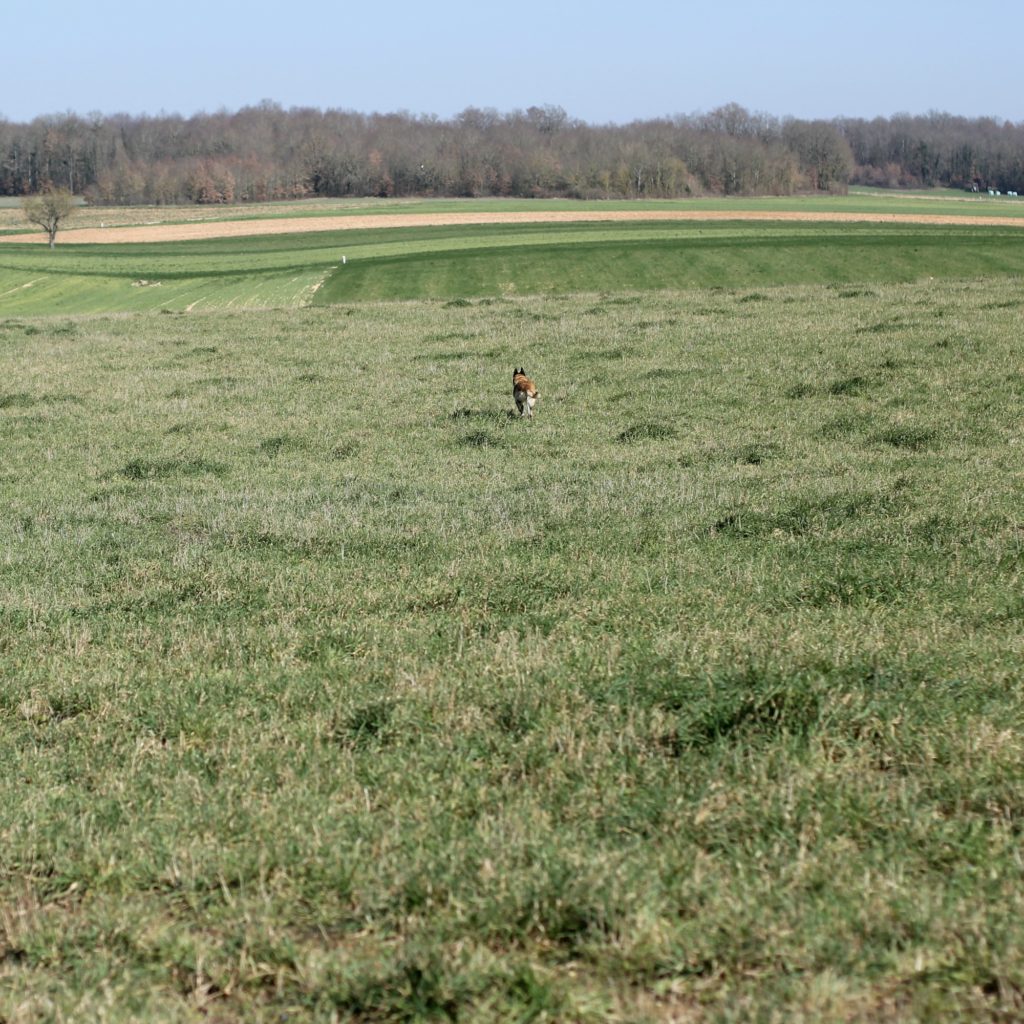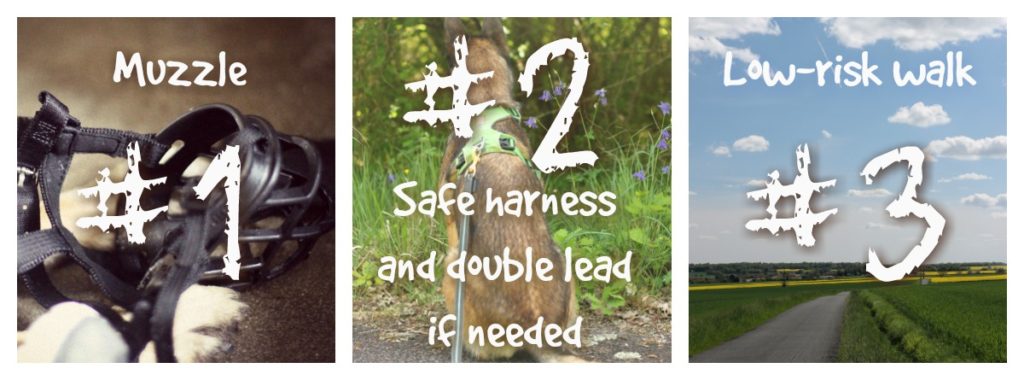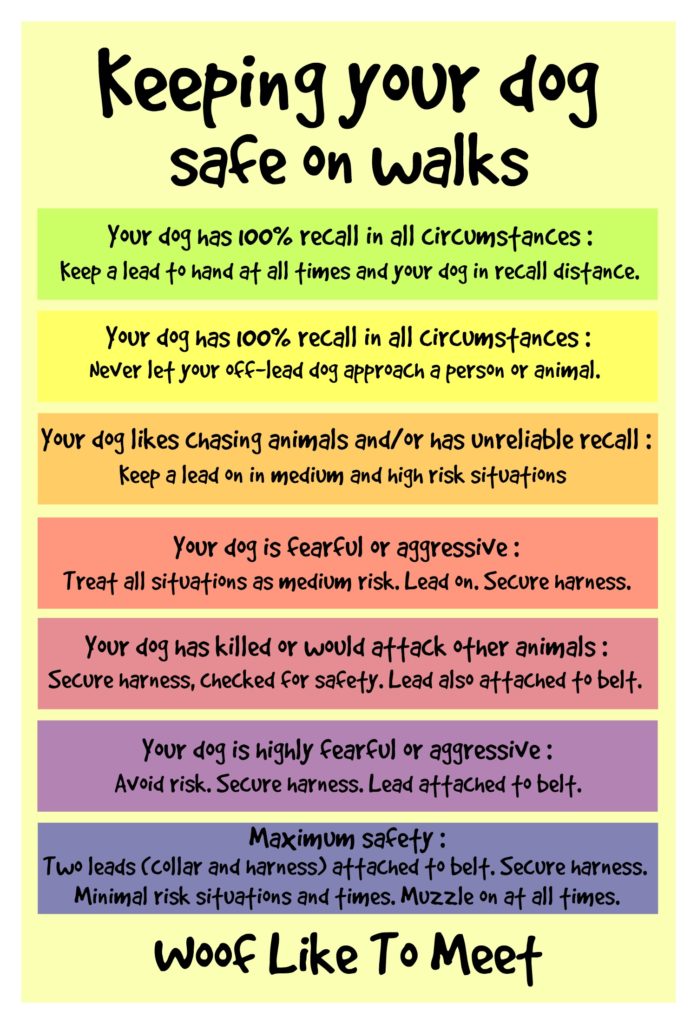I make no bones about it: I love a challenge. And I work with some dogs with pretty challenging behaviour. Sometimes that means making some adjustments in the dog’s life, be that for the duration of the training programme (with an aim of phasing those adjustments out) or for the duration of the dog’s life.
What I’m exploring today is how you can keep your dogs as safe as possible without compromising your daily walk.
Why am I even thinking about this?
What I love about dogs is that they are so utterly predictable. What I hate about people is that they aren’t.
For instance, I know my Heston. Crowds, he can handle. Hunters, he can handle. Joggers at the lake in groups, he can handle. Isolated joggers running towards us when he’s spotted them coming over 200m away, he can’t handle.
Predictable.
And I can predict what he’ll do. First he’ll see them and stop. He’ll assess the situation. He’ll decide they’re a threat. He’ll start pulling towards them. He growls. He’ll back and bark as they go past and if they’re too close, there’ll be lunges as well. He doesn’t snap or bite. To be honest, with a bark like his, he doesn’t need to.
So predictable I’d put money on his behaviour.
But people aren’t predictable. Never bet on what a person will do next.
Like last week when I saw a jogger coming towards us about 300m away or so. I turned round, backtracked, slipped behind a fence and waited until she’d gone past. She saw me and I have no doubt she saw me trying to clip Tilly back onto the lead and wrestle Flika who decided the best way to avoid going back the way she came was to stage a sit-in.
The jogger went past, and I came out and continued with my walk…
Only then to hear her coming up behind us and running back towards us! No matter that it’s a full circuit and she had no reason to turn and about face that I could think of.
Completely unpredictable.
And not only that, we’ve so lost touch with what might be frightening to an animal that we’ve lost sight of the fact that for every other species, if a predator runs head on at you at speed, it has one intention: to threaten or attack.
Bulls know that when dogs run up to them, it’s threat or attack.
The only reason a predatory species would do that to a prey species ends with being attacked or killed.
I did feel like asking the woman what the bloody hell she was playing at, but people are so unpredictable I don’t know how it would have ended.
But I had done my bit to keep my dogs safe. Both my dodgy recallers are on leads. And Tilly was on the lead because I’m respectful. I don’t know how that jogger feels about dogs. She could be frightened of them.
But my dodgy recallers stayed on the lead long after the jogger had disappeared over the horizon.
Yes, that’s pretty much permanent. Sometimes they’re on 3 metre leads and sometimes 10 metre leads. Unless Heston is working, he’s on the lead. He’s not savvy enough to know when working is and when he’s not supposed to freelance.
No, I don’t feel like I’m depriving my dog of the primordial experience of galloping free through nature because guess what?
This happens.
Yes, that’s my 14 year old mali girl with chronic arthritis and hyperattachment buggering off across a field like a greyhound out of the slips.
Luckily, there were no cars, roads, cows, dogs or people hanging about. Flika is super friendly with all of those things.
Flika’s recall – or lack of – is predictable. Cars, cows, people and dogs are cause to bolt. Cows are pretty predictable. I know where they live and in a world without cars, people and dogs, I could happily let her gallop off and hope that she’d come home eventually as long as there were no cow fields along the way. In actual fact, she’s practically by my side most of the time and if I felt lucky, I could let her off lead.
But I also know what she’d do then. The first is find animal crap. The second is to roll in it and the third is to test if it’s edible.
Those are disgusting if not particularly dangerous, right?
Well, rolling in stuff requires a bath. I don’t know if you’ve ever tried bathing an old mali who’s got rickety bones? The less I have to manoeuvre her and manipulate her, the better. Every time I do, it takes out a huge withdrawal from our trust account and one day that will end badly, I know.
So I could do without unnecessary baths.
And eating animal crap isn’t the end of the world… until she comes to some poisoned meat, or gets worms… Or worse. Decaying corpses aren’t too good for the health, really.
Could I teach her? I guess. A solid recall. A solid leave it. Counter-conditioning around cows, cars, people and dogs?
But she’s 14. She got here 6 months ago and we’ve got our head around not pulling like a husky and not wandering all over like a beagle.
So she walks on a lead. She pootles. We hang around. I follow her nose. She is safe and alive and I don’t have to wring my hands after a terrible accident and say, ‘if only that cow hadn’t kicked her to death’ or ‘if only that car had seen her coming!’
Yes, you can accuse me of exaggerating in the name of making an argument. Except I’ve picked up dead dogs from cow fields and I don’t need to tell you how many lost dogs end up as dead dogs due to poor road sense.
And even if it doesn’t end up like that, I respect cows enough to know they don’t need a batty old mali cantering around after them to kiss them/chase them/whatever. My dogs are not more important in the universe that they get the automatic right to chase stuff.
And that’s my normal non-aggressive dog. Flighty Flika. Lead on.
Tilly has her lead on sometimes. Past vegetable plots and cow fields mainly. She is a spaniel and foraging for tomatoes, strawberries and cow pats is second nature. Again, mildly annoying, but she’s practically deaf now.
Amigo had his lead on most of the last few months. Canine dementia and deafness don’t tend to end well when they meet up with roads or forests.
Heston has his lead on most of the time. Whilst his prey drive is under control, he is too predictable with unpredictable joggers. That may only be 10 days out of 365, but even so. Lead off where I can see for miles. Lead on where I can’t.
What worries me though is this thought that many people seem to have that a dog ‘deserves’ to be off lead, that it ‘needs’ to be off-lead or that it has a right to be off-lead. I know I don’t have to share the story of the spaniel killed in Manchester for running up to two dogs. Sure, worst case scenario and rare, I know. Heston has never had a scrap with an off-lead dog running up to him, but every single time one runs up to him, it doesn’t do him any good at all. It’s not “friendly”. It’s over-friendly, it’s over-confident and it’s rude. A dog who rampages up to other dogs hasn’t got good manners and isn’t sociable. It is rude and bad mannered.
And I’ve had a battle with some clients to get them to understand that. Your dog is not friendly. It’s the equivalent of Donald Trump at a Playboy party.
Not only that, if your dog is fearful and might bolt, if they’re predatory and they might chase, or they’re aggressive and they might make a bit of a scene, you owe it to your dog to keep them safe. If they can’t be trusted not to eat rubbish, if they can’t be trusted not to chase a bike, if they can’t be trusted not to trot off into people’s veg plots and steal tomatoes, they need to be on a lead.
And the faces on clients when I say this!
It reminds me of an episode of some pet show whose name I can’t remember. Trainer Craig Ogilvie was working with this out-of-control labrador. The woman was horrified when he suggested she kept the dog on the lead to stop it barrelling up to other dogs and getting in scraps and to stop it eating animal excrement. It had already seen a vet for a number of reasons, gastrointestinal problems being one. She seriously looked as if giving the dog up would be a better solution than keeping it on lead. Mind you, seeing the dog walking on lead made me realise why she let it off so often. Our fearful, aggressive and predatory dogs, or those who like eating from Nature’s Buffet, can pull like steam trains and forget their learning.
But really?
You’d really rather relinquish your dog than put them on a lead?!
It’s too horrifying to think that they might be able to enjoy life beyond the house to somewhat less of a degree than the rule-less mayhem they were living in before?
Yes, I’ve had an argument with the owner of a German shepherd who had a nasty car-chasing habit. That was going to end really, really badly. But put him on a lead?
Deprive him of his freedom?
I said, ‘what would you prefer? 2000€ vets’ bills? A dead dog? or a safe dog?’
I don’t think that’s a ridiculous decision.
Yet it was as if I was suggesting the dog be locked in a glass prison like Hannibal Lector.
And there is also a vision that it will be forever.
It may be.
I’m not going to lie to you.
Certain problems may warrant the permanent wearing of a lead when out in public. A dog who has killed another animal is one. A dog who has bitten is another. Predation is a third reason as it can be really, really challenging to stop that automatic motor pattern. And a dog who is fearful and may disappear is another.
I always start out with that as my baseline. They may have to be on a lead on walks for the rest of their natural born lives to stop them getting splatted/kicked/bumped/squished/squashed/attacked/bitten/euthanised … and I can live with that.
After all, I clunk-click every trip.
My ‘freedom’ to not wear a seatbelt pales in significance with being alive.
But instead of seeing a lead like we see a seat-belt, as a useful thing that is a bit of a restriction but keeps us safe should the worst happen, we see leads as some kind of mobile prison.
I don’t understand that.
Not only that, if I am working with dogs on their fear or aggression, the last thing I want is them practising it.
We have this vision, don’t we, that ‘they’ll get used to it’, they’ll ‘get over it’.
Nope. They never get used to it. They never get over it. They just keep doing what they’re doing, getting better at it every time they practise.
From the relatively safe world of Tilly, who is practically always off-lead once away from cars, I also deal with dogs at the other end of the spectrum. Dogs who present an elevated level of fear, predation or aggression that it is so pronounced that they present a danger to themselves, to other animals or to people.
For incredibly fearful dogs like this, I would wonder if walks were beneficial, but I can envisage scenarios in which they may find pleasure in walks. And aggression too.
But these dogs don’t necessarily have to be completely deprived of a walk.
The first step is to ensure a two-lead system. One lead attached to a secure collar and to a secure joring or canicross belt. A secure harness (ruffwear webmaster is great – six buckles) that is regularly checked for safety and to make sure the buckles don’t fail. One dog I worked with has a harness that, even if the buckle fails, he’s still secure in it. A dog who is doubly attached – with lockable carabiner clips securing the lead at both ends – is a dog who can’t get away. They need to be walked by one person – a person whose entire focus is on that one dog. No phones. No music. No other dogs on lead. Balance harness, front attaching harness or even a conditioned head halter if necessary, although I hate these. Dogmatics is the only one I recommend or would use and only after extensive desensitisation to wearing it.
If they’ve a bite history or potential to bite, then a muzzle they’ve been gradually trained to wear is also a must.
And the final piece of the puzzle is a safe walk away from triggers, threats or prey. Drive if you have to. And if you get there, do a circuit in your car if necessary.
Never, ever lower your guard, even if you think it’s safe to do so without having had a really good risk assessment first.
One of the unpredictably aggressive dogs I work with lives like this. He has hundreds of great walks every year. His owners walk him three times a day. They drive to a number of pre-planned, pre-approved walks where they can predict and anticipate things that Niro sees as a threat. They have a great harness, a canicross belt with one bungee lead attached, a really great fixed length 3m lead and a muzzle.
And their dog is safe.
He enjoys his walks. He loves that time with them. He potters. He sniffs. They do some tracking work with him and scentwork. His aggression levels have dropped so significantly that we can now try other walks.
But as his owners said, “He’s never going to enjoy walks with other people or other dogs. He can cope now because of the training plan when he does see people or dogs. We even had a small terrier run up to us but because we always walk him together, my girlfriend went off to intercept the terrier and I walked off with Niro.”
Is that such a bad life?
In rural France, it’s definitely a possible life.
Sure, he is no longer wandering around town frightening old ladies or grabbing bikes by the tyres. He’s not barked at anyone on a walk for over 18 months. He doesn’t have the right to wander all over the place like he was, but he definitely wasn’t very good at doing that and the time he attacked a cat put an end to it.
In the meantime, because he’s not practising the behaviours any more, we can work on other things. One day, we might get to a one-lead situation, but we don’t have that as a goal. To be overly-ambitious or overly-confident about your dog’s ability to cope in the outside world is to place their safety and the safety of other people or animals in jeopardy.
This is absolutely one time when you’re better safe than sorry.
So don’t test your dog if you do have 100% recall. Keep a lead handy. I shan’t tell you about the annoying labrador man who goes jogging round our end without a lead. And his dog certainly does not have 100% recall.
Expect that, in the course of a dog’s life, that recall WILL fail at some point. Are you in safe enough circumstances as Flika was that it doesn’t matter? I promise you that what causes a recall failure won’t usually be a ‘safe’ situation!
Keep working on your recall and keep it strong and well-rewarded.
If you see dogs or people, ask first. Don’t let your dog run up first and then recall them. Those people may be happy to say hi to your dog, and if they’ve got a Flika, their dog may be glad to say hi. Ask first, that’s all.
And if your dog is bordering on 100% lead on, it’s worth investing in a behaviourist or positive trainer to help you overcome these issues.
In the meantime, no practising. There are so many ways that you can keep your dog safe without depriving them of exercise or stimulation, without them living like a hermit or a prisoner.
It may not be forever. You might just have to do this for the life of a modification plan.
But if not, it’s not the end of the world, is it? Safety trumps unlimited, ungoverned rule-less freedom every time.
Next up: how you can keep dogs safe in your home and garden if you have a dog with elevated risks of aggression, predation or fear.

